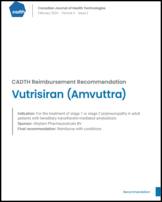|
Initiation
|
|---|
| 1. Treatment with vutrisiran should be reimbursed in adult patients with stage 1 or stage 2 genetically confirmed hATTR-PN who are symptomatic with early-stage neuropathy, defined as: 1.1. PND stage I to ≤ IIIB, or FAP stage I or II 1.2. no severe heart failure symptoms (defined as NYHA class III or IV) 1.3. no previous liver transplant. | In the HELIOS-A trial, vutrisiran demonstrated clinically meaningful benefits for patients with stage 1 or stage 2 hATTR-PN when compared to placebo. Patients with advanced polyneuropathy (i.e., PND stage IV or FAP stage III) and prior liver transplant were excluded from the HELIOS trial; therefore, there is no evidence to support the use of vutrisiran in these patients. | Genetic testing is required to confirm a diagnosis of hATTR to differentiate this condition from other causes of amyloidosis. |
|
Renewal
|
|---|
| 2. An initial clinical assessment of treatment response should occur 9 months after treatment initiation. Thereafter, patients should be assessed at least every 6 months to determine whether they would benefit from continued treatment with vutrisiran. | According to the clinical expert, patients’ overall functioning, quality of life, and ability to perform daily activities are determined through comprehensive clinical history. Continuous clinical assessments ensure accurate monitoring of the patient's response to treatment. In addition, it is common to monitor TTR levels in patients as part of monitoring response to treatment. Timing of assessments depends on the severity of the disease (if asymptomatic or minimally symptomatic, yearly assessments is acceptable); in patients with more active disease, assessments every 3 or 6 months are appropriate. | — |
|
Discontinuation
|
|---|
| 3. Treatment with vutrisiran should be discontinued for patients who are: 3.1. permanently bedridden and dependent on assistance for basic activities of daily living, or 3.2. receiving end-of-life care. | No evidence was identified to demonstrate that continuing treatment with vutrisiran in patients whose disease has progressed is effective. | — |
|
Prescribing
|
|---|
| 4. The patient must be under the care of a specialist with experience in the diagnosis and management of hATTR-PN. | This will help ensure that vutrisiran is prescribed only for appropriate patients and adverse effects are managed in an optimized and timely manner. | — |
| 5.Vutrisiran should not be used in combination with other interfering ribonucleic acid drugs or transthyretin stabilizers used to treat hATTR. | There are no data supporting the efficacy and safety of vutrisiran when used in combination with other interfering ribonucleic acid drugs or transthyretin stabilizers. | — |
|
Pricing
|
|---|
| 6. Vutrisiran should be negotiated so that it does not exceed the drug program cost of treatment with the least costly treatment reimbursed for hATTR-PN. | There is insufficient evidence to justify a cost premium for vutrisiran over the least costly treatment reimbursed for hATTR-PN. | — |
